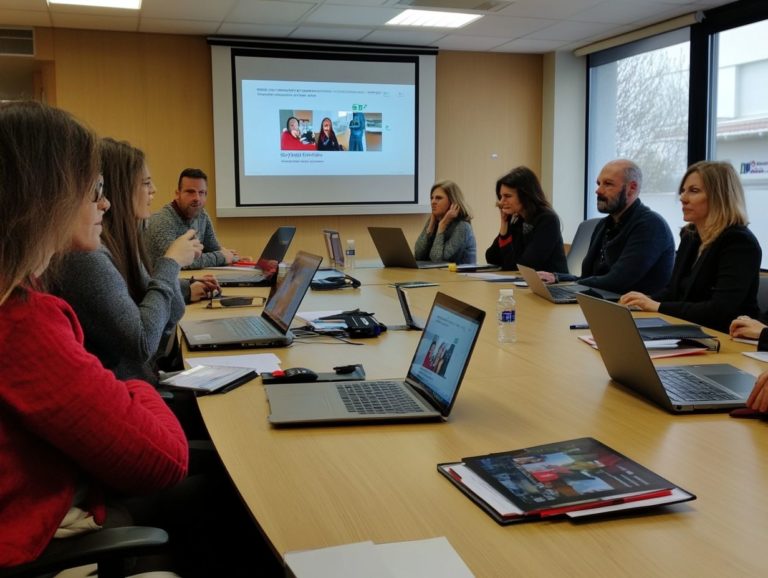E-Learning: A Tool for Global Workforce Training
The landscape of education has undergone a remarkable transformation in recent years, with e-learning becoming an essential tool for training today s global workforce.
This exploration delves into the history and evolution of online learning, showcasing its numerous benefits, including unmatched flexibility, cost-effectiveness, and personalized experiences tailored to individual needs.
Implementing e-learning has its challenges like technological barriers and cultural differences that may arise.
To help you navigate these complexities, we present best practices aimed at ensuring successful e-learning experiences. Join in as you journey through this dynamic educational frontier.
Contents
- Key Takeaways:
- The Rise of E-Learning
- Benefits of E-Learning for Global Workforce Training
- Challenges of Implementing E-Learning for Global Workforce Training
- Best Practices for Successful E-Learning Implementation
- Frequently Asked Questions
- 1. What is E-Learning and how is it different from traditional training methods?
- 2. How can E-Learning help with global workforce training?
- 3. Are there any specific skills or technical requirements for employees to participate in E-Learning?
- 4. Can E-Learning be personalized for different types of learners?
- 5. Is E-Learning only suitable for technical or skill-based training?
- 6. How can companies ensure the effectiveness of E-Learning for global workforce training?
Key Takeaways:

- E-Learning offers flexible and accessible training for the global workforce, allowing employees to learn at their own pace and from any location.
- Implementing E-Learning can result in cost savings for companies, as there is no need for travel or physical resources.
- Successful E-Learning requires effective content design, engaging learning methods, and continuous evaluation and improvement to overcome technological and cultural barriers.
The Rise of E-Learning
The rise of eLearning signifies a transformative era in workplace training and skills development, propelled by technological advancements and a growing demand for flexible learning experiences. What began as traditional training methods has now evolved dramatically, leveraging digital platforms to offer accessible and cost-effective solutions that cater to a variety of learning styles.
Leading companies such as IBM and Amazon have recognized this shift, seamlessly integrating eLearning into their training initiatives. This not only boosts employee engagement and productivity but also cultivates a culture of continuous learning, ensuring that teams stay ahead in today s fast-paced environment.
History and Evolution of Online Learning
The history of online learning traces back to the late 20th century when educational institutions began exploring digital platforms to enhance workplace training and instructional design.
This initial venture into digital education set the stage for significant milestones, including the emergence of Learning Management Systems (LMS) software that helps manage and deliver training online in the early 2000s. These systems revolutionized the way you, as an instructor or learner, engage with content.
As technology advanced, the shift from traditional classroom settings to online environments became increasingly evident. This transformation enabled a more personalized approach to education, with interactive modules and multimedia resources enriching your learning experience.
By embracing eLearning principles, educators and institutions not only enhanced accessibility but also diversified instructional methods, catering to a broader array of learning styles and needs that resonate with you.
Benefits of E-Learning for Global Workforce Training
E-Learning presents a wealth of advantages for training a global workforce, establishing itself as the preferred choice for corporate training initiatives focused on using e-learning for talent development strategies that elevate employee engagement and develop essential skills.
By offering a flexible and cost-effective approach to education, you can customize training materials to cater to the diverse needs of your employees, accommodating various learning styles and geographical locations. This flexibility empowers your workforce to learn in ways that best suit them in an increasingly dynamic environment.
Discover how e-learning can transform your team’s development today!
Flexibility and Accessibility
Flexibility and accessibility stand out as two of the most significant advantages of eLearning, making it an ideal match for the modern workforce, particularly in today s remote work environment.
With eLearning platforms at your fingertips, you can customize your learning experience to align with your individual schedule and preferred pace. This fosters a truly personalized approach to skill development.
Whether you choose to tackle a quick module during a break or dive deep into a topic after hours, you have the freedom to navigate content that specifically addresses your needs.
Features like mobile access, multi-language support, and interactive elements ensure that everyone regardless of background or location can easily engage with the material. This adaptability not only enhances understanding but significantly boosts your overall productivity and engagement, allowing you to feel empowered to advance your skills on your own terms.
Cost-Effectiveness

You can t afford to miss out on the incredible benefits of eLearning, especially its remarkable cost-effectiveness, which drastically cuts training expenses compared to traditional methods.
By eliminating the need for physical training spaces, you can save significantly on rent and utilities while minimizing the demand for expensive materials. Digital platforms offer instant access to a wealth of interactive content and tools.
eLearning also removes the travel costs linked to off-site training programs, empowering employees to learn at their own pace and convenience. This streamlined approach not only reduces costs but also enhances skill development and knowledge retention, ultimately maximizing your return on investment through a more engaged and proficient workforce.
Customized Learning Experience
Imagine a learning experience tailor-made just for you this is the power of eLearning! The ability to provide a customized learning experience enables you to tailor training materials to suit your individual needs and unique learning styles.
This personalized approach not only enhances the relevance of the content but also empowers you to take ownership of your learning journey. With smart learning tools that adjust based on your performance and engagement levels, you re ensured that you re never left behind.
As a result, you re more likely to stay motivated and engaged, benefiting from a user-centric design that truly resonates with their preferences. By fostering a more dynamic and responsive learning environment, organizations can ultimately maximize your potential, driving both productivity and satisfaction.
Challenges of Implementing E-Learning for Global Workforce Training
Implementing eLearning for global workforce training offers a wealth of advantages, yet it also presents a variety of challenges that you must navigate carefully. Understanding the evolution of e-learning in corporate training can help you address technological barriers and cultural differences that may become significant hurdles.
As your organization broadens its horizons, grasping and addressing these challenges is essential for the success of your corporate training initiatives. Understanding this landscape will empower you to optimize your training efforts and drive impactful results.
Technological Barriers
Technological barriers can stand in the way of effective eLearning, often arising from inadequate technological requirements or insufficient training on the software used to manage courses and learner progress.
These challenges can take many forms, such as poor internet connections that can cut off online classes abruptly, leaving learners feeling frustrated. You might also encounter software incompatibility issues that hinder easy access to essential online resources or cause delays during lessons.
To overcome these obstacles, it s essential for organizations to invest in comprehensive training programs for staff on new tools. By doing this, you can ensure that your teams are well-prepared to navigate the digital landscape, facilitating smoother transitions to eLearning and ultimately enhancing educational outcomes.
Cultural Differences
Cultural differences can significantly influence the effectiveness of eLearning in global corporate training. This impact is felt in both employee engagement and knowledge retention.
These variations often emerge in communication styles. Some individuals may appreciate directness, while others might lean towards a more nuanced approach.
Learning preferences also vary across cultures. Some learners excel with visual aids, while others thrive in hands-on environments. Work ethics often differ widely. Certain cultures prioritize punctuality and individual performance, while others value teamwork and flexibility.
To navigate these challenges, organizations must tailor eLearning programs to accommodate diverse preferences. This can be achieved by incorporating interactive elements, offering multiple formats, and fostering a supportive learning community that encourages collaboration among employees from various backgrounds.
Best Practices for Successful E-Learning Implementation

For organizations aiming to implement eLearning successfully, following best practices is essential. Focus on effective content design, employ engaging and interactive learning methods, and continuously evaluate training programs.
By following these strategies, you ensure that the learning experience remains relevant and effective, perfectly aligning with your organizational training goals.
Effective Content Design
Effective content design is crucial in eLearning. It ensures that your training materials resonate with employees and enhance knowledge retention through well-structured learning materials.
Imagine a vibrant learning environment with videos, infographics, and interactive quizzes! This dynamic approach caters to various learning styles and keeps engagement levels high throughout the training process.
Choosing the right content delivery methods, such as mobile learning or self-paced modules, can significantly impact how effectively employees absorb information.
Leveraging feedback mechanisms is vital. This allows learners to reflect on their understanding and seek support when necessary, leading to a more meaningful educational experience.
Engaging and Interactive Learning Methods
Incorporating engaging learning methods, like gamification using game-like features to make learning fun and assessment tools, greatly enhances your eLearning experience. These methods boost both employee motivation and knowledge retention.
Transforming traditional content delivery into dynamic learning pathways stimulates active participation. For example, integrating quizzes and instant feedback mechanisms assesses understanding and fosters a sense of accomplishment.
Introducing game-like elements, such as rewards, levels, and challenges, makes the educational journey enjoyable, tapping into your intrinsic motivation.
These approaches not only enhance comprehension of complex topics but also cultivate a supportive learning environment where you feel confident exploring new concepts. Act now to enhance your team’s learning experience!
Continuous Evaluation and Improvement
Continuous evaluation and improvement are crucial for maximizing the effectiveness of your eLearning programs. This allows you to leverage insights based on data to refine and enhance the learning experience.
This iterative approach gives you the power to pinpoint both strengths and weaknesses within your training modules. By implementing ongoing assessment strategies think quizzes, surveys, and analytics tools you can collect essential feedback on learner engagement, content relevance, and overall satisfaction.
These insights enable you to make timely adjustments in your teaching methods. This ensures that your curriculum stays aligned with the evolving needs and preferences of your learners.
Embracing a feedback-driven culture not only nurtures a dynamic learning environment but also enhances retention and encourages your learners to actively engage in their educational journey.
Frequently Asked Questions
1. What is E-Learning and how is it different from traditional training methods?

E-Learning is a form of training that utilizes electronic technologies to deliver educational content to learners. It differs from traditional training methods in that it is primarily delivered online and can be accessed remotely, at any time, and from any location with internet access.
2. How can E-Learning help with global workforce training?
E-Learning is a powerful tool for global workforce training, as it allows for the delivery of consistent and standardized training content to employees located in different parts of the world. This approach is especially beneficial for bridging knowledge gaps in corporations.
It also eliminates the need for travel and reduces training costs, making it a more efficient and cost-effective option for global companies.
3. Are there any specific skills or technical requirements for employees to participate in E-Learning?
The technical requirements for E-Learning vary depending on the platform or software being used. Employees will need access to a computer or mobile device with an internet connection, as well as basic computer skills such as navigating through online content and using basic software programs.
4. Can E-Learning be personalized for different types of learners?
Yes, one of the main advantages of E-Learning is that it can be customized. This includes incorporating different learning styles, such as visual, auditory, or kinesthetic.
Additionally, it offers options for self-paced learning or interactive activities.
5. Is E-Learning only suitable for technical or skill-based training?
No, E-Learning can be used for a wide range of training purposes. This includes soft skills development, compliance training, and leadership training.
Some platforms even offer courses on topics such as diversity and inclusion, communication skills, and project management.
6. How can companies ensure the effectiveness of E-Learning for global workforce training?
To ensure the effectiveness of E-Learning for global workforce training, companies should choose a reliable and user-friendly platform. Additionally, they can focus on enhancing employee skills with e-learning solutions by providing proper training and support for employees.
Regularly updating and reviewing training content, along with gathering feedback from learners, will continuously improve the training experience.






